Workforce Planning and Talent Management Analysis for Argos Ltd Report
VerifiedAdded on 2023/02/02
|15
|4612
|60
Report
AI Summary
This report provides a comprehensive analysis of resource and talent planning within Argos Ltd. It begins by examining current labor market trends, such as demographic shifts, economic changes, and social trends, and their influence on talent management and workforce planning. The report then delves into the legal requirements Argos must consider, including anti-discrimination acts, wage and hour regulations, and equal employment opportunity laws. Furthermore, it identifies current and anticipated skills needs based on these trends and legal requirements, including communication, competitiveness, coordination, and the need for human interaction and creative problem-solving. The report also explores job descriptions, person specifications, and various recruitment and selection methods. Finally, it assesses the application of HR lifecycle stages and their integration within Argos's organizational HR strategy, concluding with key findings and recommendations for effective talent management.
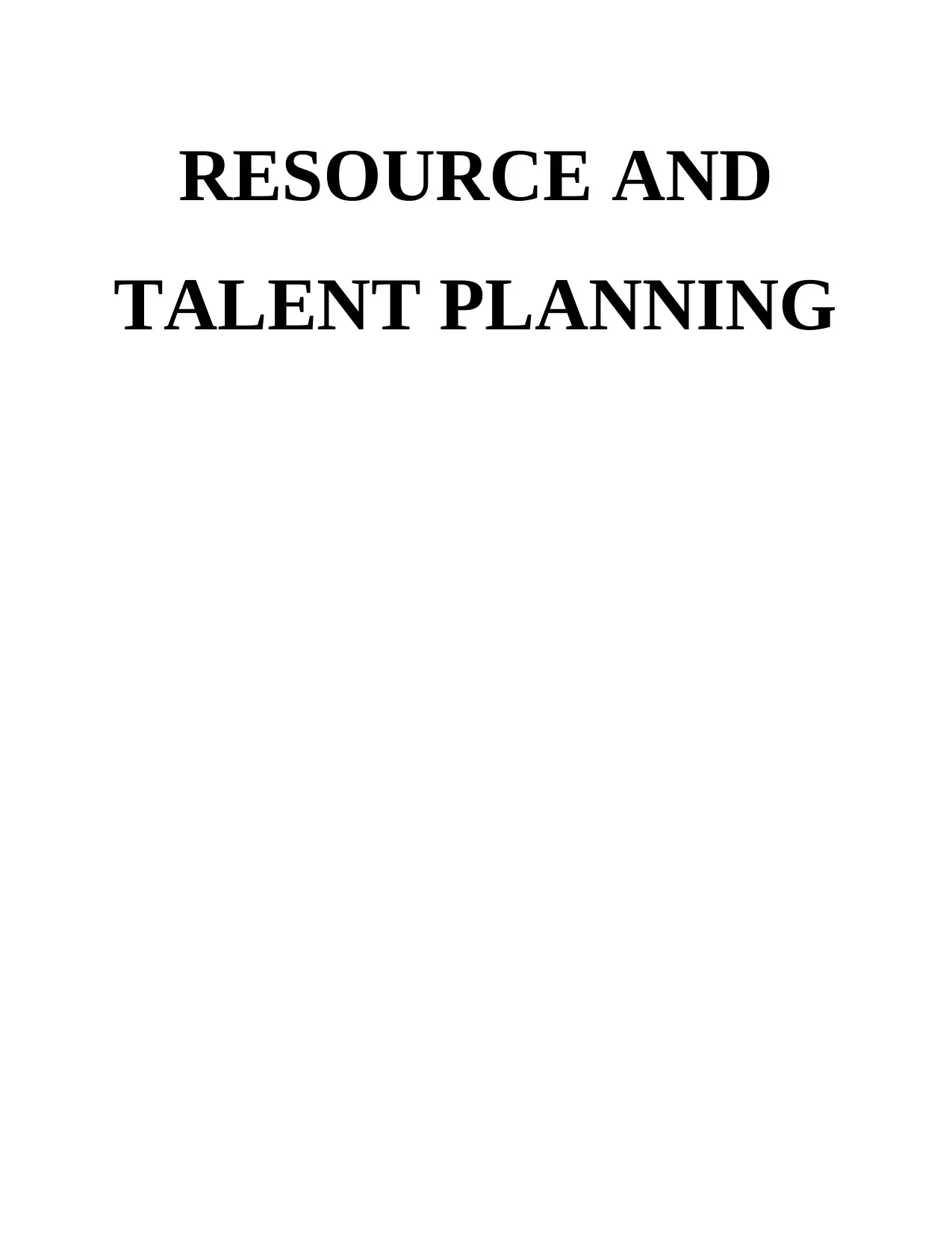
RESOURCE AND
TALENT PLANNING
TALENT PLANNING
Paraphrase This Document
Need a fresh take? Get an instant paraphrase of this document with our AI Paraphraser
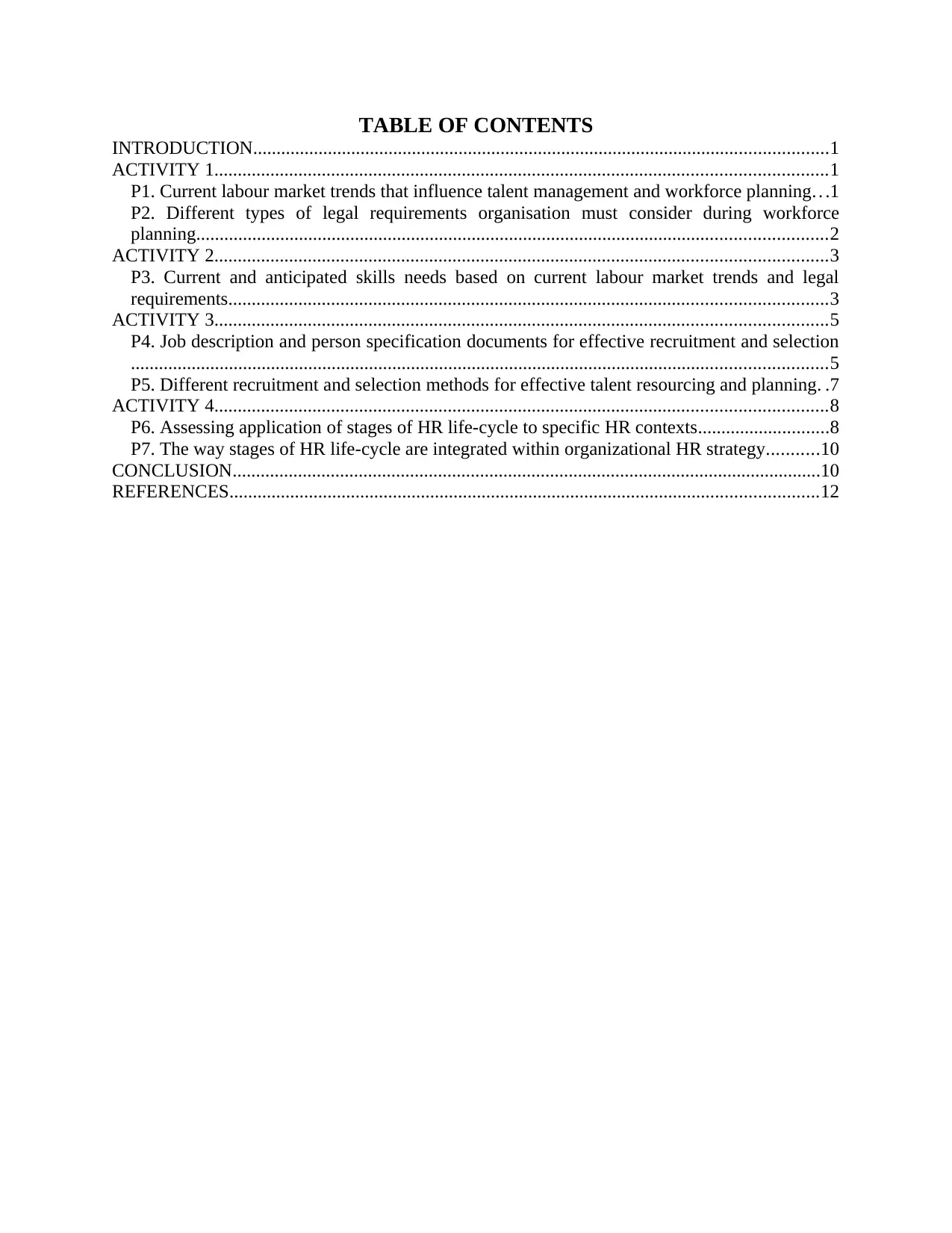
TABLE OF CONTENTS
INTRODUCTION...........................................................................................................................1
ACTIVITY 1...................................................................................................................................1
P1. Current labour market trends that influence talent management and workforce planning. . .1
P2. Different types of legal requirements organisation must consider during workforce
planning.......................................................................................................................................2
ACTIVITY 2...................................................................................................................................3
P3. Current and anticipated skills needs based on current labour market trends and legal
requirements................................................................................................................................3
ACTIVITY 3...................................................................................................................................5
P4. Job description and person specification documents for effective recruitment and selection
.....................................................................................................................................................5
P5. Different recruitment and selection methods for effective talent resourcing and planning. .7
ACTIVITY 4...................................................................................................................................8
P6. Assessing application of stages of HR life-cycle to specific HR contexts............................8
P7. The way stages of HR life-cycle are integrated within organizational HR strategy...........10
CONCLUSION..............................................................................................................................10
REFERENCES..............................................................................................................................12
INTRODUCTION...........................................................................................................................1
ACTIVITY 1...................................................................................................................................1
P1. Current labour market trends that influence talent management and workforce planning. . .1
P2. Different types of legal requirements organisation must consider during workforce
planning.......................................................................................................................................2
ACTIVITY 2...................................................................................................................................3
P3. Current and anticipated skills needs based on current labour market trends and legal
requirements................................................................................................................................3
ACTIVITY 3...................................................................................................................................5
P4. Job description and person specification documents for effective recruitment and selection
.....................................................................................................................................................5
P5. Different recruitment and selection methods for effective talent resourcing and planning. .7
ACTIVITY 4...................................................................................................................................8
P6. Assessing application of stages of HR life-cycle to specific HR contexts............................8
P7. The way stages of HR life-cycle are integrated within organizational HR strategy...........10
CONCLUSION..............................................................................................................................10
REFERENCES..............................................................................................................................12
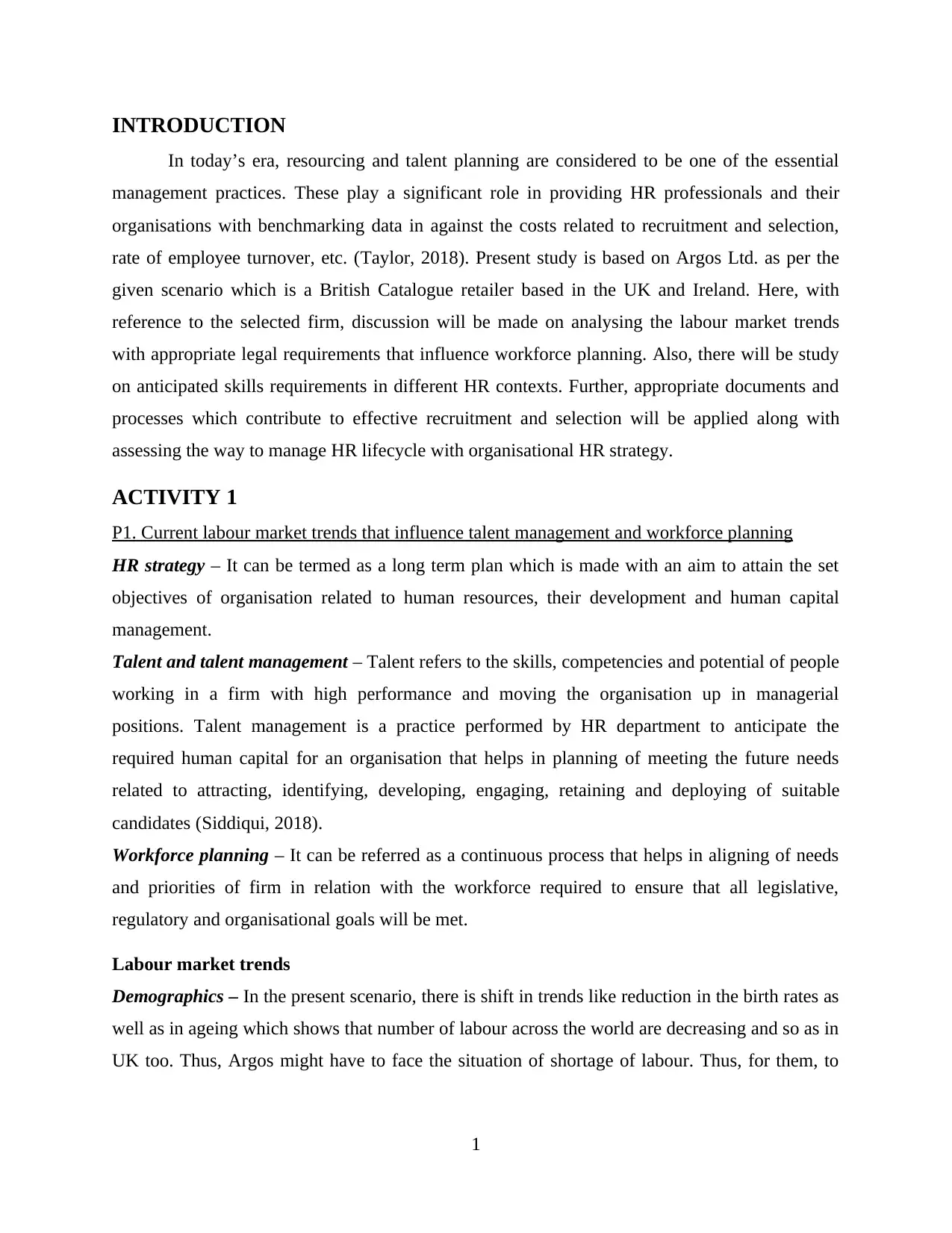
INTRODUCTION
In today’s era, resourcing and talent planning are considered to be one of the essential
management practices. These play a significant role in providing HR professionals and their
organisations with benchmarking data in against the costs related to recruitment and selection,
rate of employee turnover, etc. (Taylor, 2018). Present study is based on Argos Ltd. as per the
given scenario which is a British Catalogue retailer based in the UK and Ireland. Here, with
reference to the selected firm, discussion will be made on analysing the labour market trends
with appropriate legal requirements that influence workforce planning. Also, there will be study
on anticipated skills requirements in different HR contexts. Further, appropriate documents and
processes which contribute to effective recruitment and selection will be applied along with
assessing the way to manage HR lifecycle with organisational HR strategy.
ACTIVITY 1
P1. Current labour market trends that influence talent management and workforce planning
HR strategy – It can be termed as a long term plan which is made with an aim to attain the set
objectives of organisation related to human resources, their development and human capital
management.
Talent and talent management – Talent refers to the skills, competencies and potential of people
working in a firm with high performance and moving the organisation up in managerial
positions. Talent management is a practice performed by HR department to anticipate the
required human capital for an organisation that helps in planning of meeting the future needs
related to attracting, identifying, developing, engaging, retaining and deploying of suitable
candidates (Siddiqui, 2018).
Workforce planning – It can be referred as a continuous process that helps in aligning of needs
and priorities of firm in relation with the workforce required to ensure that all legislative,
regulatory and organisational goals will be met.
Labour market trends
Demographics – In the present scenario, there is shift in trends like reduction in the birth rates as
well as in ageing which shows that number of labour across the world are decreasing and so as in
UK too. Thus, Argos might have to face the situation of shortage of labour. Thus, for them, to
1
In today’s era, resourcing and talent planning are considered to be one of the essential
management practices. These play a significant role in providing HR professionals and their
organisations with benchmarking data in against the costs related to recruitment and selection,
rate of employee turnover, etc. (Taylor, 2018). Present study is based on Argos Ltd. as per the
given scenario which is a British Catalogue retailer based in the UK and Ireland. Here, with
reference to the selected firm, discussion will be made on analysing the labour market trends
with appropriate legal requirements that influence workforce planning. Also, there will be study
on anticipated skills requirements in different HR contexts. Further, appropriate documents and
processes which contribute to effective recruitment and selection will be applied along with
assessing the way to manage HR lifecycle with organisational HR strategy.
ACTIVITY 1
P1. Current labour market trends that influence talent management and workforce planning
HR strategy – It can be termed as a long term plan which is made with an aim to attain the set
objectives of organisation related to human resources, their development and human capital
management.
Talent and talent management – Talent refers to the skills, competencies and potential of people
working in a firm with high performance and moving the organisation up in managerial
positions. Talent management is a practice performed by HR department to anticipate the
required human capital for an organisation that helps in planning of meeting the future needs
related to attracting, identifying, developing, engaging, retaining and deploying of suitable
candidates (Siddiqui, 2018).
Workforce planning – It can be referred as a continuous process that helps in aligning of needs
and priorities of firm in relation with the workforce required to ensure that all legislative,
regulatory and organisational goals will be met.
Labour market trends
Demographics – In the present scenario, there is shift in trends like reduction in the birth rates as
well as in ageing which shows that number of labour across the world are decreasing and so as in
UK too. Thus, Argos might have to face the situation of shortage of labour. Thus, for them, to
1
⊘ This is a preview!⊘
Do you want full access?
Subscribe today to unlock all pages.

Trusted by 1+ million students worldwide
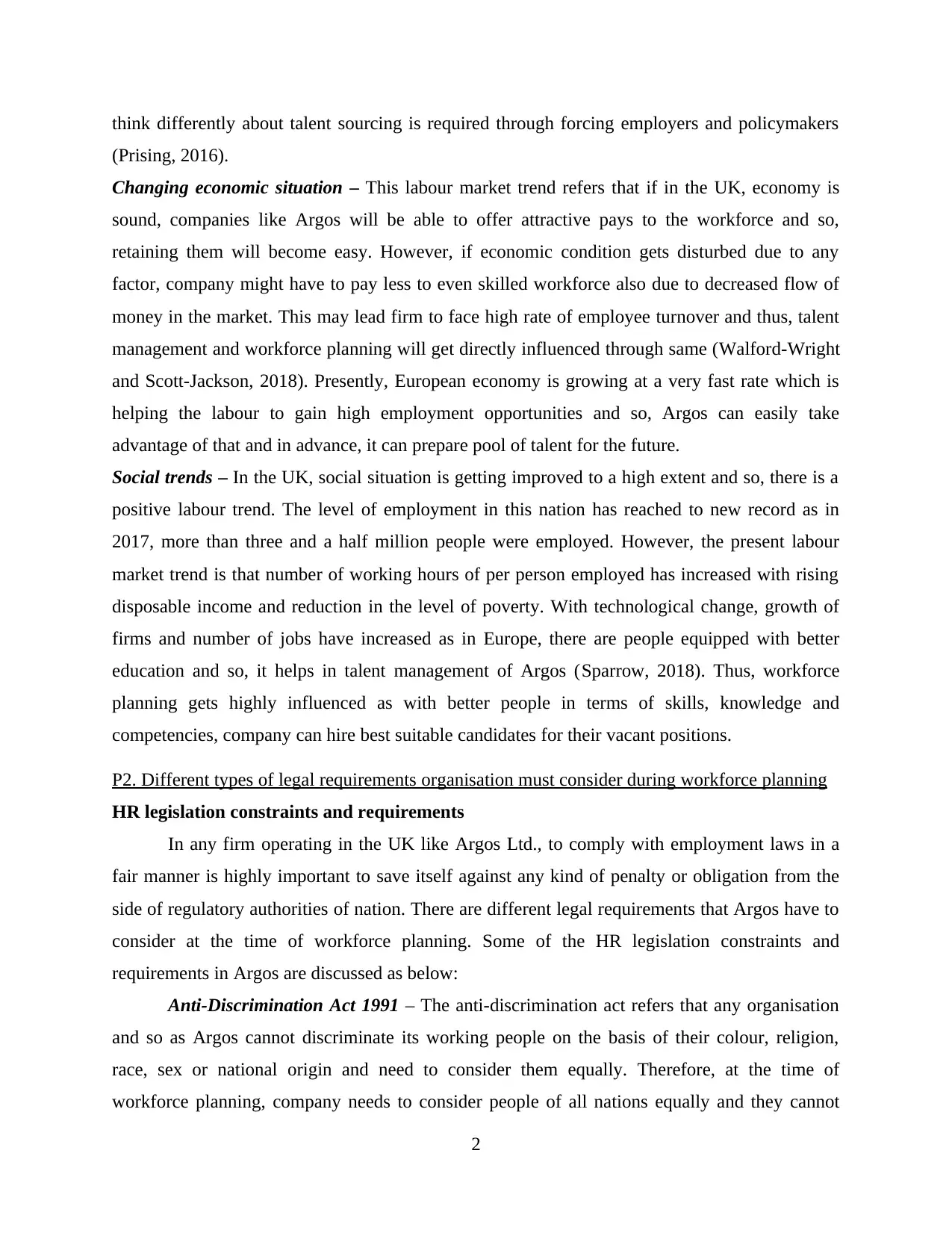
think differently about talent sourcing is required through forcing employers and policymakers
(Prising, 2016).
Changing economic situation – This labour market trend refers that if in the UK, economy is
sound, companies like Argos will be able to offer attractive pays to the workforce and so,
retaining them will become easy. However, if economic condition gets disturbed due to any
factor, company might have to pay less to even skilled workforce also due to decreased flow of
money in the market. This may lead firm to face high rate of employee turnover and thus, talent
management and workforce planning will get directly influenced through same (Walford-Wright
and Scott-Jackson, 2018). Presently, European economy is growing at a very fast rate which is
helping the labour to gain high employment opportunities and so, Argos can easily take
advantage of that and in advance, it can prepare pool of talent for the future.
Social trends – In the UK, social situation is getting improved to a high extent and so, there is a
positive labour trend. The level of employment in this nation has reached to new record as in
2017, more than three and a half million people were employed. However, the present labour
market trend is that number of working hours of per person employed has increased with rising
disposable income and reduction in the level of poverty. With technological change, growth of
firms and number of jobs have increased as in Europe, there are people equipped with better
education and so, it helps in talent management of Argos (Sparrow, 2018). Thus, workforce
planning gets highly influenced as with better people in terms of skills, knowledge and
competencies, company can hire best suitable candidates for their vacant positions.
P2. Different types of legal requirements organisation must consider during workforce planning
HR legislation constraints and requirements
In any firm operating in the UK like Argos Ltd., to comply with employment laws in a
fair manner is highly important to save itself against any kind of penalty or obligation from the
side of regulatory authorities of nation. There are different legal requirements that Argos have to
consider at the time of workforce planning. Some of the HR legislation constraints and
requirements in Argos are discussed as below:
Anti-Discrimination Act 1991 – The anti-discrimination act refers that any organisation
and so as Argos cannot discriminate its working people on the basis of their colour, religion,
race, sex or national origin and need to consider them equally. Therefore, at the time of
workforce planning, company needs to consider people of all nations equally and they cannot
2
(Prising, 2016).
Changing economic situation – This labour market trend refers that if in the UK, economy is
sound, companies like Argos will be able to offer attractive pays to the workforce and so,
retaining them will become easy. However, if economic condition gets disturbed due to any
factor, company might have to pay less to even skilled workforce also due to decreased flow of
money in the market. This may lead firm to face high rate of employee turnover and thus, talent
management and workforce planning will get directly influenced through same (Walford-Wright
and Scott-Jackson, 2018). Presently, European economy is growing at a very fast rate which is
helping the labour to gain high employment opportunities and so, Argos can easily take
advantage of that and in advance, it can prepare pool of talent for the future.
Social trends – In the UK, social situation is getting improved to a high extent and so, there is a
positive labour trend. The level of employment in this nation has reached to new record as in
2017, more than three and a half million people were employed. However, the present labour
market trend is that number of working hours of per person employed has increased with rising
disposable income and reduction in the level of poverty. With technological change, growth of
firms and number of jobs have increased as in Europe, there are people equipped with better
education and so, it helps in talent management of Argos (Sparrow, 2018). Thus, workforce
planning gets highly influenced as with better people in terms of skills, knowledge and
competencies, company can hire best suitable candidates for their vacant positions.
P2. Different types of legal requirements organisation must consider during workforce planning
HR legislation constraints and requirements
In any firm operating in the UK like Argos Ltd., to comply with employment laws in a
fair manner is highly important to save itself against any kind of penalty or obligation from the
side of regulatory authorities of nation. There are different legal requirements that Argos have to
consider at the time of workforce planning. Some of the HR legislation constraints and
requirements in Argos are discussed as below:
Anti-Discrimination Act 1991 – The anti-discrimination act refers that any organisation
and so as Argos cannot discriminate its working people on the basis of their colour, religion,
race, sex or national origin and need to consider them equally. Therefore, at the time of
workforce planning, company needs to consider people of all nations equally and they cannot
2
Paraphrase This Document
Need a fresh take? Get an instant paraphrase of this document with our AI Paraphraser

refuse to hire an employee or dismiss him because of the any of the reasons like their colour or
national origin (Employment Law and Compliance, 2019).
Wage and Hour – According to The Fair Labour Standards Act (FLSA), it is mandatory
for Argos to provide federal minimum wages to the workers that is to be revised on a periodic
basis. HR professionals in company are required verify the accuracy of payment made to
employees on continuous basis. Further, if employees are doing overtime, they have to be paid
extra for respective hours. Thus, workforce planning in Argos gets impacted as keeping in
consideration the same, HR manager needs to ensure about proper classification of employees
based on their job duties (Malik, 2018).
Equal Employment Opportunity Act 1972 – As per this act, Argos is not allowed to
make any kind of illegal discrimination with its workforce on the basis of age, gender or race and
need to provide equal employment opportunities to all. Thus, while workforce planning,
vacancies of company should be open for all and they have to consider them on equal grounds
irrespective of their race, age or gender.
Rise in Ethical Awareness – One of the major legal requirements of Argos to be
considered during workforce planning is rise in the ethical awareness. In the current era,
employees are well aware with all laws which protect them against any kind of injustice (Li and
et.al., 2018). Therefore, at the time of workforce planning, it is important for Argos to do
recruitment and selection keeping in mind all legislations so that risk of any penalty or obligation
can be reduced and process can be done in a fair manner.
Increased Competitive Intensity and Globalisation – There is one more requirement
which is to be considered by Argos while workforce planning i.e. rise in the competition as well
as globalisation. As today’s business environment is highly dynamic and there are number of
competitors available to the firm due to globalisation, so, it is crucial that people who will be
selected by the organisation must be highly skilled and proficient enough to lead organisation to
gain a competitive edge over others (Wójcik, 2018).
3
national origin (Employment Law and Compliance, 2019).
Wage and Hour – According to The Fair Labour Standards Act (FLSA), it is mandatory
for Argos to provide federal minimum wages to the workers that is to be revised on a periodic
basis. HR professionals in company are required verify the accuracy of payment made to
employees on continuous basis. Further, if employees are doing overtime, they have to be paid
extra for respective hours. Thus, workforce planning in Argos gets impacted as keeping in
consideration the same, HR manager needs to ensure about proper classification of employees
based on their job duties (Malik, 2018).
Equal Employment Opportunity Act 1972 – As per this act, Argos is not allowed to
make any kind of illegal discrimination with its workforce on the basis of age, gender or race and
need to provide equal employment opportunities to all. Thus, while workforce planning,
vacancies of company should be open for all and they have to consider them on equal grounds
irrespective of their race, age or gender.
Rise in Ethical Awareness – One of the major legal requirements of Argos to be
considered during workforce planning is rise in the ethical awareness. In the current era,
employees are well aware with all laws which protect them against any kind of injustice (Li and
et.al., 2018). Therefore, at the time of workforce planning, it is important for Argos to do
recruitment and selection keeping in mind all legislations so that risk of any penalty or obligation
can be reduced and process can be done in a fair manner.
Increased Competitive Intensity and Globalisation – There is one more requirement
which is to be considered by Argos while workforce planning i.e. rise in the competition as well
as globalisation. As today’s business environment is highly dynamic and there are number of
competitors available to the firm due to globalisation, so, it is crucial that people who will be
selected by the organisation must be highly skilled and proficient enough to lead organisation to
gain a competitive edge over others (Wójcik, 2018).
3
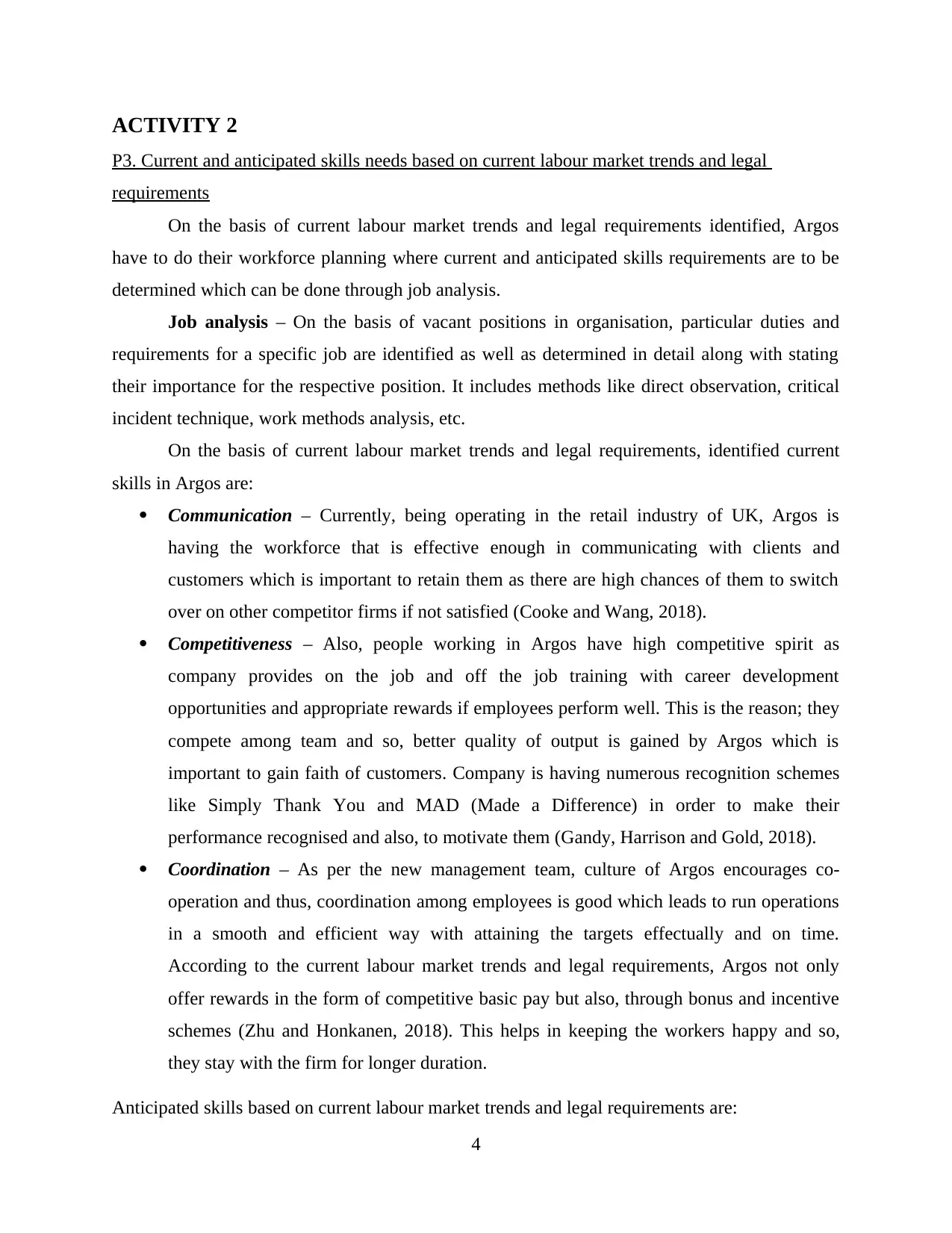
ACTIVITY 2
P3. Current and anticipated skills needs based on current labour market trends and legal
requirements
On the basis of current labour market trends and legal requirements identified, Argos
have to do their workforce planning where current and anticipated skills requirements are to be
determined which can be done through job analysis.
Job analysis – On the basis of vacant positions in organisation, particular duties and
requirements for a specific job are identified as well as determined in detail along with stating
their importance for the respective position. It includes methods like direct observation, critical
incident technique, work methods analysis, etc.
On the basis of current labour market trends and legal requirements, identified current
skills in Argos are:
Communication – Currently, being operating in the retail industry of UK, Argos is
having the workforce that is effective enough in communicating with clients and
customers which is important to retain them as there are high chances of them to switch
over on other competitor firms if not satisfied (Cooke and Wang, 2018).
Competitiveness – Also, people working in Argos have high competitive spirit as
company provides on the job and off the job training with career development
opportunities and appropriate rewards if employees perform well. This is the reason; they
compete among team and so, better quality of output is gained by Argos which is
important to gain faith of customers. Company is having numerous recognition schemes
like Simply Thank You and MAD (Made a Difference) in order to make their
performance recognised and also, to motivate them (Gandy, Harrison and Gold, 2018).
Coordination – As per the new management team, culture of Argos encourages co-
operation and thus, coordination among employees is good which leads to run operations
in a smooth and efficient way with attaining the targets effectually and on time.
According to the current labour market trends and legal requirements, Argos not only
offer rewards in the form of competitive basic pay but also, through bonus and incentive
schemes (Zhu and Honkanen, 2018). This helps in keeping the workers happy and so,
they stay with the firm for longer duration.
Anticipated skills based on current labour market trends and legal requirements are:
4
P3. Current and anticipated skills needs based on current labour market trends and legal
requirements
On the basis of current labour market trends and legal requirements identified, Argos
have to do their workforce planning where current and anticipated skills requirements are to be
determined which can be done through job analysis.
Job analysis – On the basis of vacant positions in organisation, particular duties and
requirements for a specific job are identified as well as determined in detail along with stating
their importance for the respective position. It includes methods like direct observation, critical
incident technique, work methods analysis, etc.
On the basis of current labour market trends and legal requirements, identified current
skills in Argos are:
Communication – Currently, being operating in the retail industry of UK, Argos is
having the workforce that is effective enough in communicating with clients and
customers which is important to retain them as there are high chances of them to switch
over on other competitor firms if not satisfied (Cooke and Wang, 2018).
Competitiveness – Also, people working in Argos have high competitive spirit as
company provides on the job and off the job training with career development
opportunities and appropriate rewards if employees perform well. This is the reason; they
compete among team and so, better quality of output is gained by Argos which is
important to gain faith of customers. Company is having numerous recognition schemes
like Simply Thank You and MAD (Made a Difference) in order to make their
performance recognised and also, to motivate them (Gandy, Harrison and Gold, 2018).
Coordination – As per the new management team, culture of Argos encourages co-
operation and thus, coordination among employees is good which leads to run operations
in a smooth and efficient way with attaining the targets effectually and on time.
According to the current labour market trends and legal requirements, Argos not only
offer rewards in the form of competitive basic pay but also, through bonus and incentive
schemes (Zhu and Honkanen, 2018). This helps in keeping the workers happy and so,
they stay with the firm for longer duration.
Anticipated skills based on current labour market trends and legal requirements are:
4
⊘ This is a preview!⊘
Do you want full access?
Subscribe today to unlock all pages.

Trusted by 1+ million students worldwide
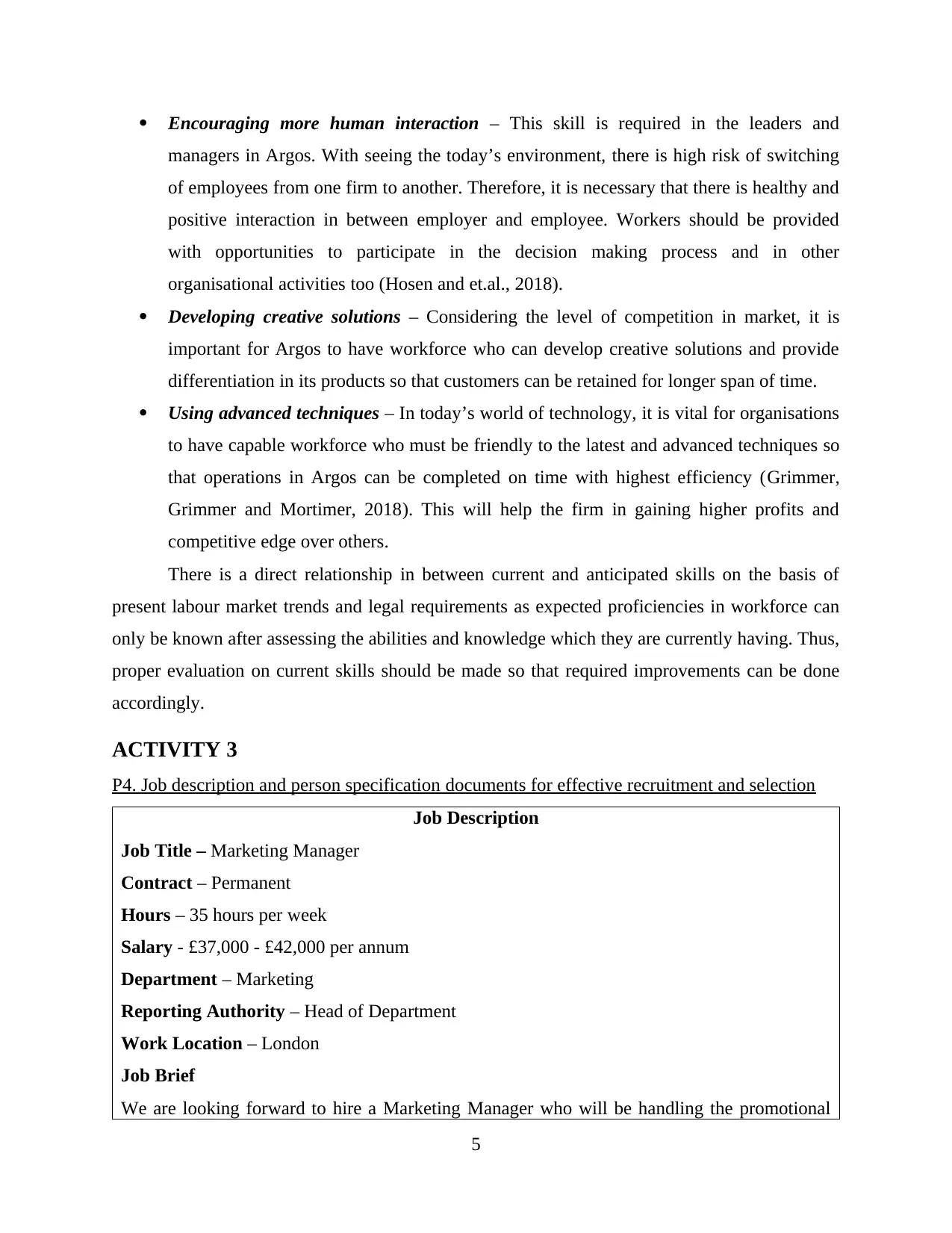
Encouraging more human interaction – This skill is required in the leaders and
managers in Argos. With seeing the today’s environment, there is high risk of switching
of employees from one firm to another. Therefore, it is necessary that there is healthy and
positive interaction in between employer and employee. Workers should be provided
with opportunities to participate in the decision making process and in other
organisational activities too (Hosen and et.al., 2018).
Developing creative solutions – Considering the level of competition in market, it is
important for Argos to have workforce who can develop creative solutions and provide
differentiation in its products so that customers can be retained for longer span of time.
Using advanced techniques – In today’s world of technology, it is vital for organisations
to have capable workforce who must be friendly to the latest and advanced techniques so
that operations in Argos can be completed on time with highest efficiency (Grimmer,
Grimmer and Mortimer, 2018). This will help the firm in gaining higher profits and
competitive edge over others.
There is a direct relationship in between current and anticipated skills on the basis of
present labour market trends and legal requirements as expected proficiencies in workforce can
only be known after assessing the abilities and knowledge which they are currently having. Thus,
proper evaluation on current skills should be made so that required improvements can be done
accordingly.
ACTIVITY 3
P4. Job description and person specification documents for effective recruitment and selection
Job Description
Job Title – Marketing Manager
Contract – Permanent
Hours – 35 hours per week
Salary - £37,000 - £42,000 per annum
Department – Marketing
Reporting Authority – Head of Department
Work Location – London
Job Brief
We are looking forward to hire a Marketing Manager who will be handling the promotional
5
managers in Argos. With seeing the today’s environment, there is high risk of switching
of employees from one firm to another. Therefore, it is necessary that there is healthy and
positive interaction in between employer and employee. Workers should be provided
with opportunities to participate in the decision making process and in other
organisational activities too (Hosen and et.al., 2018).
Developing creative solutions – Considering the level of competition in market, it is
important for Argos to have workforce who can develop creative solutions and provide
differentiation in its products so that customers can be retained for longer span of time.
Using advanced techniques – In today’s world of technology, it is vital for organisations
to have capable workforce who must be friendly to the latest and advanced techniques so
that operations in Argos can be completed on time with highest efficiency (Grimmer,
Grimmer and Mortimer, 2018). This will help the firm in gaining higher profits and
competitive edge over others.
There is a direct relationship in between current and anticipated skills on the basis of
present labour market trends and legal requirements as expected proficiencies in workforce can
only be known after assessing the abilities and knowledge which they are currently having. Thus,
proper evaluation on current skills should be made so that required improvements can be done
accordingly.
ACTIVITY 3
P4. Job description and person specification documents for effective recruitment and selection
Job Description
Job Title – Marketing Manager
Contract – Permanent
Hours – 35 hours per week
Salary - £37,000 - £42,000 per annum
Department – Marketing
Reporting Authority – Head of Department
Work Location – London
Job Brief
We are looking forward to hire a Marketing Manager who will be handling the promotional
5
Paraphrase This Document
Need a fresh take? Get an instant paraphrase of this document with our AI Paraphraser
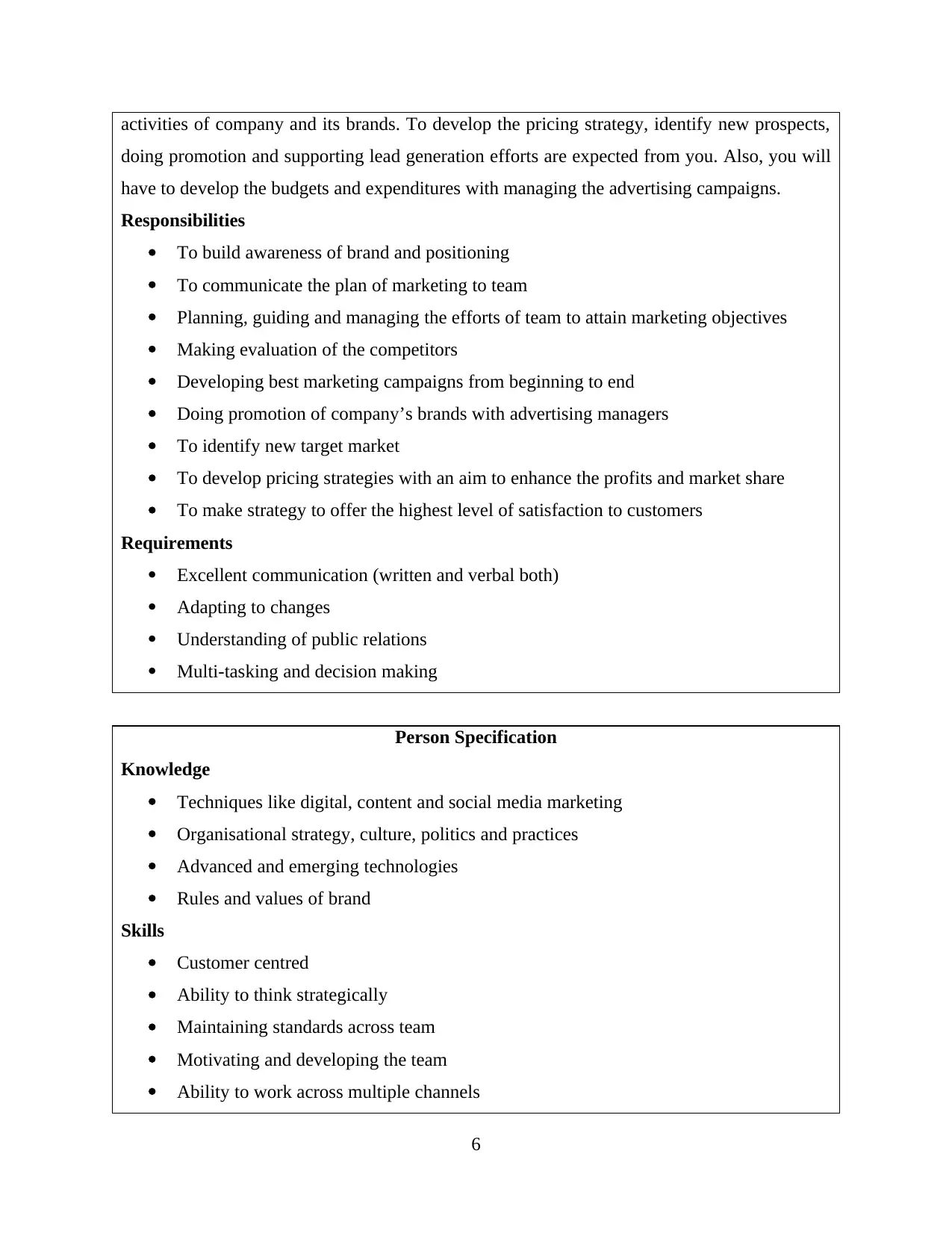
activities of company and its brands. To develop the pricing strategy, identify new prospects,
doing promotion and supporting lead generation efforts are expected from you. Also, you will
have to develop the budgets and expenditures with managing the advertising campaigns.
Responsibilities
To build awareness of brand and positioning
To communicate the plan of marketing to team
Planning, guiding and managing the efforts of team to attain marketing objectives
Making evaluation of the competitors
Developing best marketing campaigns from beginning to end
Doing promotion of company’s brands with advertising managers
To identify new target market
To develop pricing strategies with an aim to enhance the profits and market share
To make strategy to offer the highest level of satisfaction to customers
Requirements
Excellent communication (written and verbal both)
Adapting to changes
Understanding of public relations
Multi-tasking and decision making
Person Specification
Knowledge
Techniques like digital, content and social media marketing
Organisational strategy, culture, politics and practices
Advanced and emerging technologies
Rules and values of brand
Skills
Customer centred
Ability to think strategically
Maintaining standards across team
Motivating and developing the team
Ability to work across multiple channels
6
doing promotion and supporting lead generation efforts are expected from you. Also, you will
have to develop the budgets and expenditures with managing the advertising campaigns.
Responsibilities
To build awareness of brand and positioning
To communicate the plan of marketing to team
Planning, guiding and managing the efforts of team to attain marketing objectives
Making evaluation of the competitors
Developing best marketing campaigns from beginning to end
Doing promotion of company’s brands with advertising managers
To identify new target market
To develop pricing strategies with an aim to enhance the profits and market share
To make strategy to offer the highest level of satisfaction to customers
Requirements
Excellent communication (written and verbal both)
Adapting to changes
Understanding of public relations
Multi-tasking and decision making
Person Specification
Knowledge
Techniques like digital, content and social media marketing
Organisational strategy, culture, politics and practices
Advanced and emerging technologies
Rules and values of brand
Skills
Customer centred
Ability to think strategically
Maintaining standards across team
Motivating and developing the team
Ability to work across multiple channels
6
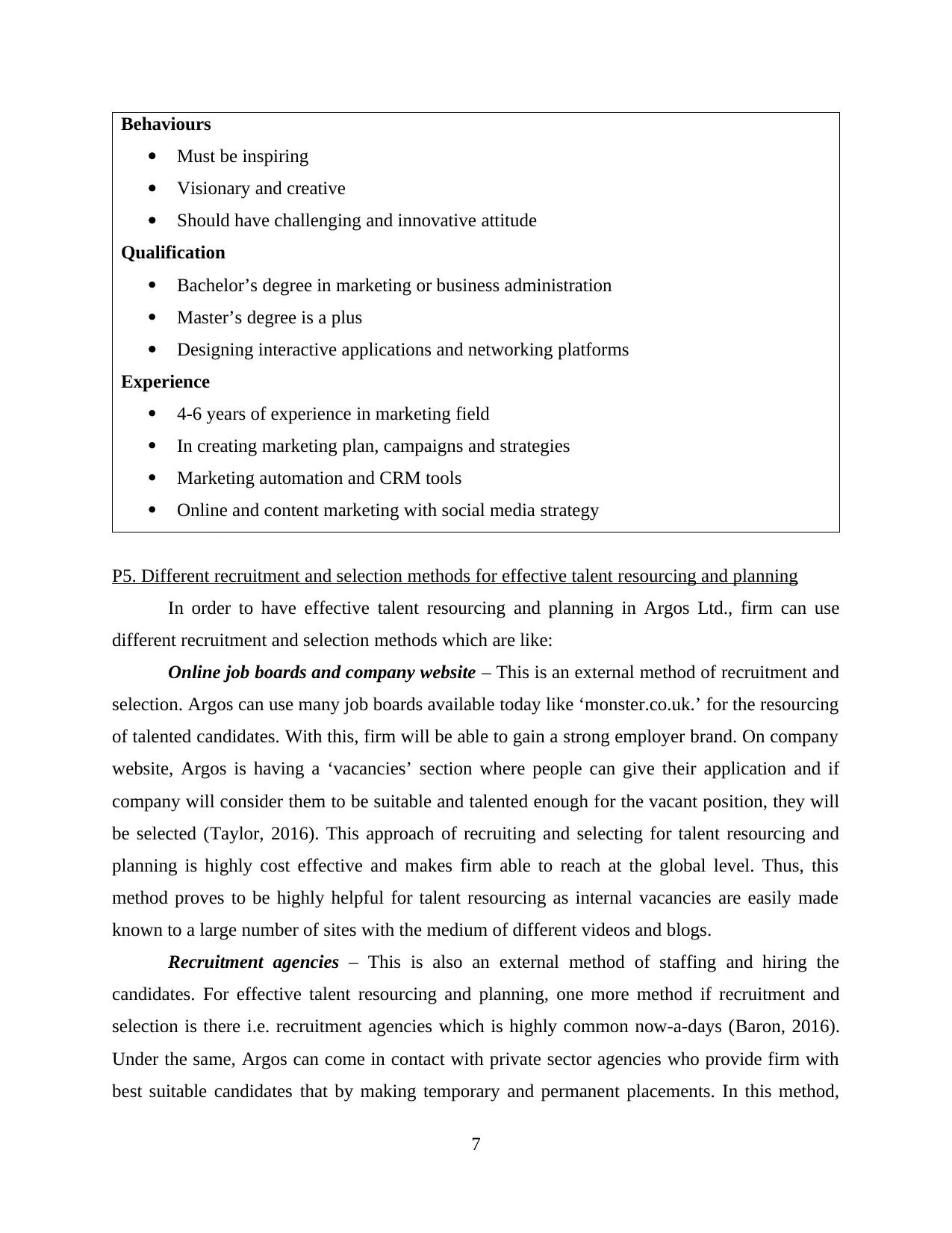
Behaviours
Must be inspiring
Visionary and creative
Should have challenging and innovative attitude
Qualification
Bachelor’s degree in marketing or business administration
Master’s degree is a plus
Designing interactive applications and networking platforms
Experience
4-6 years of experience in marketing field
In creating marketing plan, campaigns and strategies
Marketing automation and CRM tools
Online and content marketing with social media strategy
P5. Different recruitment and selection methods for effective talent resourcing and planning
In order to have effective talent resourcing and planning in Argos Ltd., firm can use
different recruitment and selection methods which are like:
Online job boards and company website – This is an external method of recruitment and
selection. Argos can use many job boards available today like ‘monster.co.uk.’ for the resourcing
of talented candidates. With this, firm will be able to gain a strong employer brand. On company
website, Argos is having a ‘vacancies’ section where people can give their application and if
company will consider them to be suitable and talented enough for the vacant position, they will
be selected (Taylor, 2016). This approach of recruiting and selecting for talent resourcing and
planning is highly cost effective and makes firm able to reach at the global level. Thus, this
method proves to be highly helpful for talent resourcing as internal vacancies are easily made
known to a large number of sites with the medium of different videos and blogs.
Recruitment agencies – This is also an external method of staffing and hiring the
candidates. For effective talent resourcing and planning, one more method if recruitment and
selection is there i.e. recruitment agencies which is highly common now-a-days (Baron, 2016).
Under the same, Argos can come in contact with private sector agencies who provide firm with
best suitable candidates that by making temporary and permanent placements. In this method,
7
Must be inspiring
Visionary and creative
Should have challenging and innovative attitude
Qualification
Bachelor’s degree in marketing or business administration
Master’s degree is a plus
Designing interactive applications and networking platforms
Experience
4-6 years of experience in marketing field
In creating marketing plan, campaigns and strategies
Marketing automation and CRM tools
Online and content marketing with social media strategy
P5. Different recruitment and selection methods for effective talent resourcing and planning
In order to have effective talent resourcing and planning in Argos Ltd., firm can use
different recruitment and selection methods which are like:
Online job boards and company website – This is an external method of recruitment and
selection. Argos can use many job boards available today like ‘monster.co.uk.’ for the resourcing
of talented candidates. With this, firm will be able to gain a strong employer brand. On company
website, Argos is having a ‘vacancies’ section where people can give their application and if
company will consider them to be suitable and talented enough for the vacant position, they will
be selected (Taylor, 2016). This approach of recruiting and selecting for talent resourcing and
planning is highly cost effective and makes firm able to reach at the global level. Thus, this
method proves to be highly helpful for talent resourcing as internal vacancies are easily made
known to a large number of sites with the medium of different videos and blogs.
Recruitment agencies – This is also an external method of staffing and hiring the
candidates. For effective talent resourcing and planning, one more method if recruitment and
selection is there i.e. recruitment agencies which is highly common now-a-days (Baron, 2016).
Under the same, Argos can come in contact with private sector agencies who provide firm with
best suitable candidates that by making temporary and permanent placements. In this method,
7
⊘ This is a preview!⊘
Do you want full access?
Subscribe today to unlock all pages.

Trusted by 1+ million students worldwide
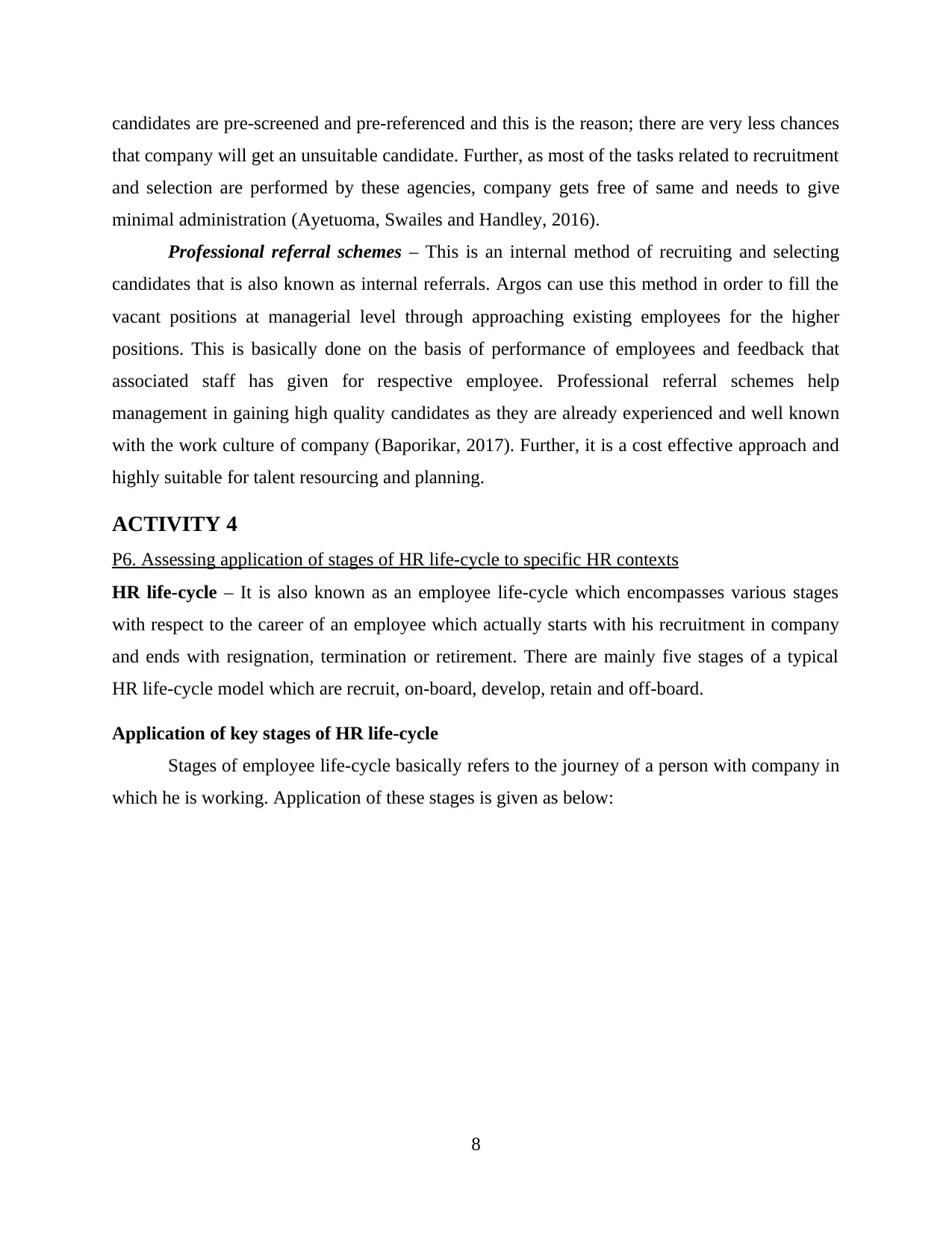
candidates are pre-screened and pre-referenced and this is the reason; there are very less chances
that company will get an unsuitable candidate. Further, as most of the tasks related to recruitment
and selection are performed by these agencies, company gets free of same and needs to give
minimal administration (Ayetuoma, Swailes and Handley, 2016).
Professional referral schemes – This is an internal method of recruiting and selecting
candidates that is also known as internal referrals. Argos can use this method in order to fill the
vacant positions at managerial level through approaching existing employees for the higher
positions. This is basically done on the basis of performance of employees and feedback that
associated staff has given for respective employee. Professional referral schemes help
management in gaining high quality candidates as they are already experienced and well known
with the work culture of company (Baporikar, 2017). Further, it is a cost effective approach and
highly suitable for talent resourcing and planning.
ACTIVITY 4
P6. Assessing application of stages of HR life-cycle to specific HR contexts
HR life-cycle – It is also known as an employee life-cycle which encompasses various stages
with respect to the career of an employee which actually starts with his recruitment in company
and ends with resignation, termination or retirement. There are mainly five stages of a typical
HR life-cycle model which are recruit, on-board, develop, retain and off-board.
Application of key stages of HR life-cycle
Stages of employee life-cycle basically refers to the journey of a person with company in
which he is working. Application of these stages is given as below:
8
that company will get an unsuitable candidate. Further, as most of the tasks related to recruitment
and selection are performed by these agencies, company gets free of same and needs to give
minimal administration (Ayetuoma, Swailes and Handley, 2016).
Professional referral schemes – This is an internal method of recruiting and selecting
candidates that is also known as internal referrals. Argos can use this method in order to fill the
vacant positions at managerial level through approaching existing employees for the higher
positions. This is basically done on the basis of performance of employees and feedback that
associated staff has given for respective employee. Professional referral schemes help
management in gaining high quality candidates as they are already experienced and well known
with the work culture of company (Baporikar, 2017). Further, it is a cost effective approach and
highly suitable for talent resourcing and planning.
ACTIVITY 4
P6. Assessing application of stages of HR life-cycle to specific HR contexts
HR life-cycle – It is also known as an employee life-cycle which encompasses various stages
with respect to the career of an employee which actually starts with his recruitment in company
and ends with resignation, termination or retirement. There are mainly five stages of a typical
HR life-cycle model which are recruit, on-board, develop, retain and off-board.
Application of key stages of HR life-cycle
Stages of employee life-cycle basically refers to the journey of a person with company in
which he is working. Application of these stages is given as below:
8
Paraphrase This Document
Need a fresh take? Get an instant paraphrase of this document with our AI Paraphraser

Figure 1: Stages of HR/employee life-cycle
1. Recruit (recruitment and selection) – This is the first stage of HR life-cycle which is all
about hiring of a new employee in organisation. Argos can use talent acquisition software
that will help them to design and automate the process of recruitment and selection
including its all aspects. This stage allows firm to use an application tracking system,
screening before employment and the scheduling of interviews which in taking follow up
of candidates (Employee life-cycle, 2019). If Argos will use talent acquisition software, it
can attract the top talent through streamlining the process of hiring.
2. On-board (on-boarding and orientation) – This is the next phase where all those
candidates who have accepted the offer given by company become its workforce. At this
stage, Argos needs to provide them with required information and tools by which they
can perform their work with high efficiency and can easily get integrate in the
organisational culture. Here, company prepares its employees to learn about its policies,
processes and duties which they are expected to perform. For the same, Argos will have
to provide suitable trainings to them.
9
Recruit
On-board
Develop
Retain
Off-board
1. Recruit (recruitment and selection) – This is the first stage of HR life-cycle which is all
about hiring of a new employee in organisation. Argos can use talent acquisition software
that will help them to design and automate the process of recruitment and selection
including its all aspects. This stage allows firm to use an application tracking system,
screening before employment and the scheduling of interviews which in taking follow up
of candidates (Employee life-cycle, 2019). If Argos will use talent acquisition software, it
can attract the top talent through streamlining the process of hiring.
2. On-board (on-boarding and orientation) – This is the next phase where all those
candidates who have accepted the offer given by company become its workforce. At this
stage, Argos needs to provide them with required information and tools by which they
can perform their work with high efficiency and can easily get integrate in the
organisational culture. Here, company prepares its employees to learn about its policies,
processes and duties which they are expected to perform. For the same, Argos will have
to provide suitable trainings to them.
9
Recruit
On-board
Develop
Retain
Off-board
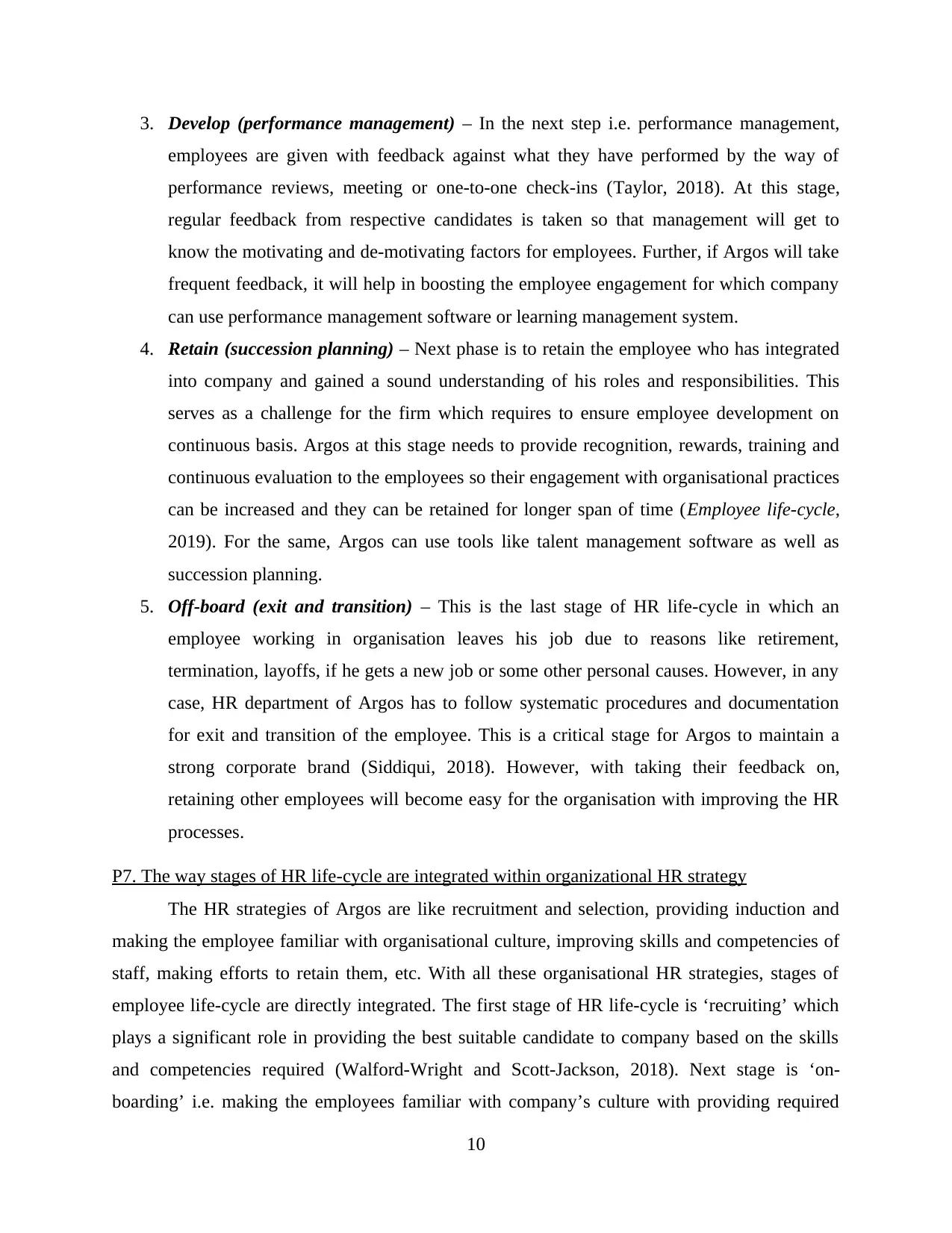
3. Develop (performance management) – In the next step i.e. performance management,
employees are given with feedback against what they have performed by the way of
performance reviews, meeting or one-to-one check-ins (Taylor, 2018). At this stage,
regular feedback from respective candidates is taken so that management will get to
know the motivating and de-motivating factors for employees. Further, if Argos will take
frequent feedback, it will help in boosting the employee engagement for which company
can use performance management software or learning management system.
4. Retain (succession planning) – Next phase is to retain the employee who has integrated
into company and gained a sound understanding of his roles and responsibilities. This
serves as a challenge for the firm which requires to ensure employee development on
continuous basis. Argos at this stage needs to provide recognition, rewards, training and
continuous evaluation to the employees so their engagement with organisational practices
can be increased and they can be retained for longer span of time (Employee life-cycle,
2019). For the same, Argos can use tools like talent management software as well as
succession planning.
5. Off-board (exit and transition) – This is the last stage of HR life-cycle in which an
employee working in organisation leaves his job due to reasons like retirement,
termination, layoffs, if he gets a new job or some other personal causes. However, in any
case, HR department of Argos has to follow systematic procedures and documentation
for exit and transition of the employee. This is a critical stage for Argos to maintain a
strong corporate brand (Siddiqui, 2018). However, with taking their feedback on,
retaining other employees will become easy for the organisation with improving the HR
processes.
P7. The way stages of HR life-cycle are integrated within organizational HR strategy
The HR strategies of Argos are like recruitment and selection, providing induction and
making the employee familiar with organisational culture, improving skills and competencies of
staff, making efforts to retain them, etc. With all these organisational HR strategies, stages of
employee life-cycle are directly integrated. The first stage of HR life-cycle is ‘recruiting’ which
plays a significant role in providing the best suitable candidate to company based on the skills
and competencies required (Walford-Wright and Scott-Jackson, 2018). Next stage is ‘on-
boarding’ i.e. making the employees familiar with company’s culture with providing required
10
employees are given with feedback against what they have performed by the way of
performance reviews, meeting or one-to-one check-ins (Taylor, 2018). At this stage,
regular feedback from respective candidates is taken so that management will get to
know the motivating and de-motivating factors for employees. Further, if Argos will take
frequent feedback, it will help in boosting the employee engagement for which company
can use performance management software or learning management system.
4. Retain (succession planning) – Next phase is to retain the employee who has integrated
into company and gained a sound understanding of his roles and responsibilities. This
serves as a challenge for the firm which requires to ensure employee development on
continuous basis. Argos at this stage needs to provide recognition, rewards, training and
continuous evaluation to the employees so their engagement with organisational practices
can be increased and they can be retained for longer span of time (Employee life-cycle,
2019). For the same, Argos can use tools like talent management software as well as
succession planning.
5. Off-board (exit and transition) – This is the last stage of HR life-cycle in which an
employee working in organisation leaves his job due to reasons like retirement,
termination, layoffs, if he gets a new job or some other personal causes. However, in any
case, HR department of Argos has to follow systematic procedures and documentation
for exit and transition of the employee. This is a critical stage for Argos to maintain a
strong corporate brand (Siddiqui, 2018). However, with taking their feedback on,
retaining other employees will become easy for the organisation with improving the HR
processes.
P7. The way stages of HR life-cycle are integrated within organizational HR strategy
The HR strategies of Argos are like recruitment and selection, providing induction and
making the employee familiar with organisational culture, improving skills and competencies of
staff, making efforts to retain them, etc. With all these organisational HR strategies, stages of
employee life-cycle are directly integrated. The first stage of HR life-cycle is ‘recruiting’ which
plays a significant role in providing the best suitable candidate to company based on the skills
and competencies required (Walford-Wright and Scott-Jackson, 2018). Next stage is ‘on-
boarding’ i.e. making the employees familiar with company’s culture with providing required
10
⊘ This is a preview!⊘
Do you want full access?
Subscribe today to unlock all pages.

Trusted by 1+ million students worldwide
1 out of 15
Related Documents
Your All-in-One AI-Powered Toolkit for Academic Success.
+13062052269
info@desklib.com
Available 24*7 on WhatsApp / Email
![[object Object]](/_next/static/media/star-bottom.7253800d.svg)
Unlock your academic potential
Copyright © 2020–2025 A2Z Services. All Rights Reserved. Developed and managed by ZUCOL.





